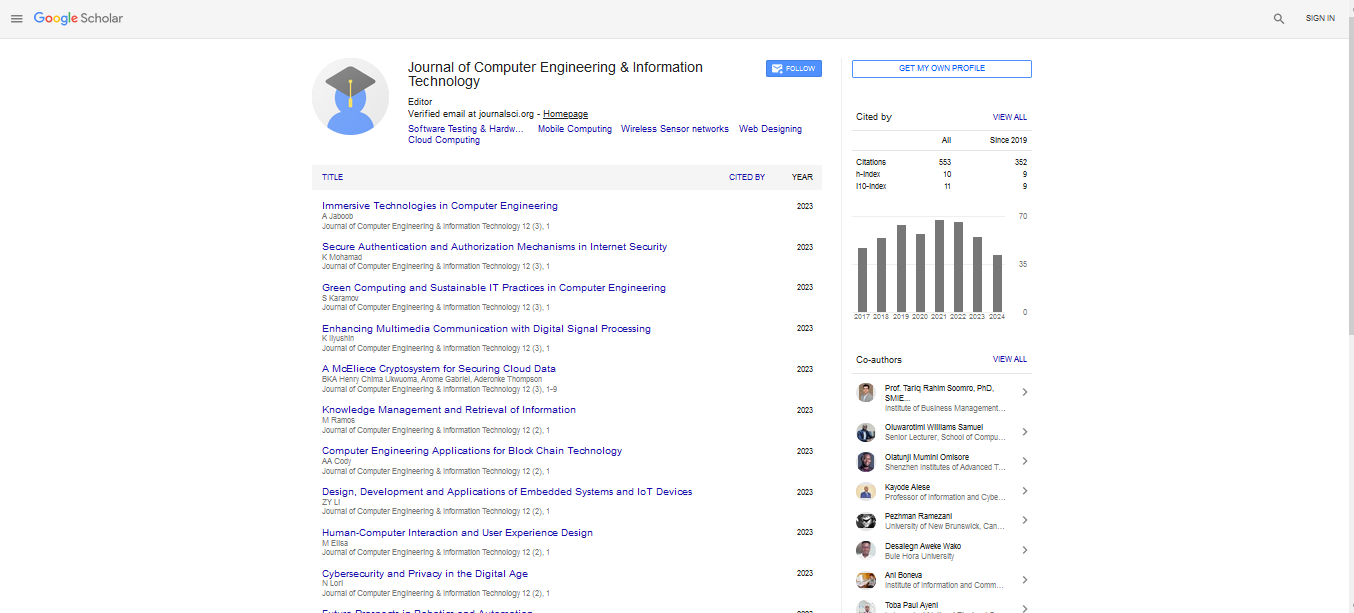Perspective, J Comput Eng Inf Technol Vol: 13 Issue: 6
A Study on 5G Network Deployment and Its Impact on IoT Applications
Latif Yan*
1Department of Data Science, Menoufia University, Shebin El-Koom, Egypt
*Corresponding Author: Latif Yan,
Mitera Hospital,
Athens, GreeceDepartment of Data Science, Menoufia University,
Shebin El-Koom, Egypt
E-mail: latif.yan@psu.edu.sa
Received date: 27 October, 2024, Manuscript No. JCEIT-24-151674;
Editor assigned date: 29 October, 2024, PreQC No. JCEIT-24-151674 (PQ);
Reviewed date: 13 November, 2024, QC No. JCEIT-24-151674;
Revised date: 21 November, 2024, Manuscript No. JCEIT-24-151674 (R);
Published date: 29 November, 2024, DOI: 10.4172/2324-9307.1000321
Citation: Yan L (2024) A Study on 5G Network Deployment and Its Impact on IoT Applications. J Comput Eng Inf Technol 13:6.
Description
The advent of 5G technology represents a revolutionary leap forward in mobile communication. With faster speeds, lower latency and greater connectivity than previous generations, 5G is poised to transform the way devices interact in the Internet of Things (IoT) ecosystem. As more industries adopt IoT solutions for automation, real-time monitoring and smart infrastructure, 5G’s influence on IoT applications will be deep, enabling a new generation of innovations that were previously constrained by 4G limitations. This study discuss the fundamentals of 5G deployment, its impact on IoT applications and the challenges and opportunities it presents for a connected world.
5G operates on a broader spectrum, incorporating three key frequency ranges low, mid and high bands. Low-band frequencies (below 1 GHz) offer wide coverage and penetrate buildings easily, though they support lower data speeds. Mid-band frequencies (1-6 GHz) offer a balance between speed and coverage, while high-band frequencies (24 GHz and above), known as millimeter waves, provide incredibly fast data transfer but have a limited range and require a dense network of small cells. Unlike 4G, which relies heavily on centralized core networks, 5G uses a more decentralized architecture, incorporating edge computing to reduce latency and handle data processing closer to the source. This shift is essential for latencysensitive IoT applications, like autonomous vehicles and real-time industrial monitoring, where rapid data processing is grave. 5G deployment involves dense networks of small cell towers and base stations, which enable the use of millimeter waves in urban environments. Massive Multiple-Input Multiple-Output (MIMO) technology further enhances 5G capacity by allowing multiple data streams simultaneously, which is particularly advantageous for areas with high device density, like IoT environments. IoT devices are expected to grow exponentially in the coming years, providing demand for a network that can handle billions of connected devices. 5G is uniquely suited to support this growth due to its ability to provide the speed, bandwidth and connectivity that IoT requires. 5G’s peak speeds, which can reach up to 10 Gbps, enable rapid data transmission for IoT applications. For instance, in a smart city, where data from thousands of sensors is constantly streaming, 5G’s speed enables real-time data analysis and instant response. This capability can be applied across numerous industries, from healthcare to transportation, where rapid data processing is vital for applications like remote patient monitoring and traffic management systems.
One of the most significant improvements 5G brings is its ultra-low latency, often reduced to 1 millisecond or less. Low latency is essential for time-sensitive IoT applications such as autonomous vehicles, industrial automation and Augmented Reality (AR). In autonomous vehicles, for example, low latency is grave for sending and receiving signals instantaneously to avoid collisions and ensure passenger safety. Similarly, in industrial settings, it enables robotic systems to operate in real time, boosting efficiency and productivity. 5G is engineered to support up to one million devices per square kilometer, making it ideal for high-density IoT applications. For instance, smart cities require connectivity for a vast array of sensors, cameras and smart devices that manage utilities, traffic, security and waste. With 5G, these devices can connect and communicate without overloading the network, ensuring seamless and efficient operation across a city or enterprise. Network slicing is a unique feature of 5G that allows for the making of virtual networks tailored to specific IoT applications. This is particularly beneficial for industries with varying connectivity needs. For example, in a hospital, network slices can be configured to prioritize grave applications, like remote surgery, over less grave applications, like administrative communications. Network slicing allows organizations to optimize performance for each IoT application, ensuring quality of service across multiple, diverse operations.
The capabilities of 5G networks will catalyze advancements across various IoT applications, including smart cities, industrial IoT, healthcare and autonomous vehicles. Smart cities rely heavily on IoT technology to improve urban living by automating transportation, managing waste, controlling lighting and monitoring pollution. 5G enables these applications by providing the capacity, speed and latency required to process data from numerous sensors in real time. For instance, with 5G-powered traffic management systems, smart cities can optimize traffic flow by adjusting signals dynamically based on real-time conditions. Additionally, 5G’s reliable connectivity can help implement energy-efficient street lighting, where lights automatically adjust based on the time of day or presence of pedestrians.
 Spanish
Spanish  Chinese
Chinese  Russian
Russian  German
German  French
French  Japanese
Japanese  Portuguese
Portuguese  Hindi
Hindi 